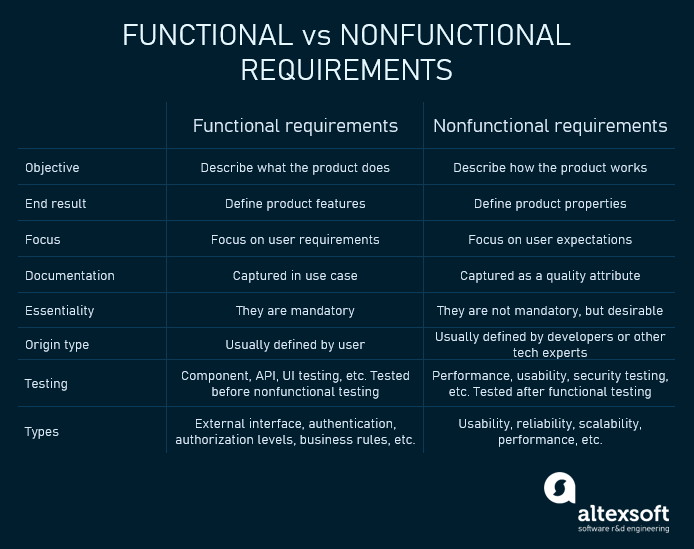
Remember, it’s not what a product will do (which are its functional requirements), but it’s what a project will be. Think about non-functional requirements as buckets that hold attributes important to the user experience. A list of potential categories, however, can give you a starting point to consider which non-functional requirements need to be on your list.

So, the non-functional requirements that you define for your project will vary based on client expectations. You might want warming seats in a new car, but somebody else might want a third row of seats. Just as with car shopping, not everyone needs the same features to make their user experience great. Focus on the user experience so the system is easy to operate and the risk for potential rework is minimized.Ensure performance in key areas such as reliability, availability, scalability, and more.Define quality attributes of the software.Instead, you might define that as “building a system that can manage at least 50,000 users over the next 24 months, so customers don’t experience the frustration of system crashes.”Īdditionally, a non-functional requirement may:

For example, you might want to build a system that can manage expansion in the future. A non-functional requirement is a statement defining a system quality, constraint, or external interface. Non-functional requirements focus on the user experience. The “ilities” of a product include quality, reliability, manufacturability, usability, serviceability, upgradeability, etc. So, now that we’ve defined non-functional requirements, how do you integrate them effectively into your product development process? And when the non-functional requirements are done well, you may eliminate 50 to 80 percent of product defects.
#Functional requirements software#
One study found that 60 to 80 percent of the cost of software development involves rework.

Non-functional requirements bridge the gap between what developers believe customers want and what customers really want. And if you miss the mark on these requirements, you may have scheduling delays, budget setbacks and unsatisfied clients.Ī project that lacks non-functional requirements may also lack clarity, which can result in vague project scope and a disconnect between the designer and client expectations. Software has non-functional requirements that are essential to creating a positive experience for the user. Non-functional requirements may be found in adverbs or modifying clauses, such as “The system prints invoices quickly” or “The system prints invoices *with confidentiality.” In systems engineering and requirements engineering, a non-functional requirement is a requirement that specifies criteria that can be used to judge the operation of a system, rather than specific behaviors. Non-functional requirements are global constraints on a software system e.g., development costs, operational costs, performance, reliability, maintainability, portability, robustness etc.Ī requirement that does not relate to functionality, but to attributes such as reliability, efficiency, usability, maintainability, and portability.


 0 kommentar(er)
0 kommentar(er)
